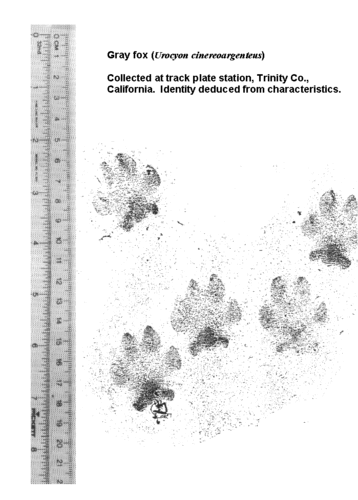Gray Fox
Urocyon cinereoargenteusDescription 3
The gray fox (Urocyon cinereoargenteus) is a mammal of the order Carnivora ranging throughout most of the southern half of North America from southern Canada to the northern part of South America (Venezuela and Colombia). This species and the closely related Channel Island fox (Urocyon littoralis) are the only living members of the genus Urocyon, which is considered to be among the most primitive of the living canids. Though it was once the most common fox...
Summary 4
Fully grown gray foxes display a mix of white, red, black and gray fur. However, new born pups tend to be dark brown. Gray foxes are medium-sized canids with elongated bodies and relatively short legs. They usually weigh between 3 and 5 kg, but can weigh up to 9 kg. Individuals at high elevation are slightly larger than their low elevation counterparts. Males are slightly larger than females, and skeletal measurements show that males have longer pelvises and calcanea, wider scapulae and more robust limb bones. In general, gray foxes can grow up to 1 m in length. Their tail makes up approximately one-third of their total body length and has a distinct black stripe along the dorsal surface and a black tip. The top of the head, back, sides, and rest of the tail are gray with the belly, chest, legs and sides of the face being reddish brown. The cheeks, muzzle and throat are white. Gray foxes have oval-shaped pupils and the area around the eyes has a thin black stripe from the outside corner of the eye to the side of the head. Additionally, a thick black stripe runs from the inside corner of the eye, down the muzzle to the mouth. They are sometimes misidentified as red foxes (Vulpes vulpes); however, red foxes have slit-shaped eyes, larger feet, longer legs, and a leaner body.
http://animaldiversity.org/accounts/Urocyon_cinereoargenteus/
Sources and Credits
- (c) James Marvin Phelps, some rights reserved (CC BY-NC), http://www.flickr.com/photos/66727626@N00/302323648
- (c) stephaniefausett, all rights reserved
- Adapted by stephaniefausett from a work by (c) Wikipedia, some rights reserved (CC BY-SA), http://en.wikipedia.org/wiki/Urocyon_cinereoargenteus
- (c) stephaniefausett, some rights reserved (CC BY-SA)









